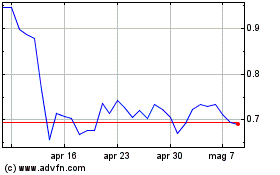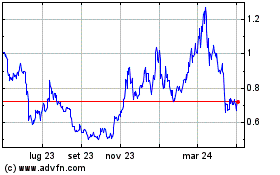MATIC Under The Lens: Why Is Polygon Busy But Not Making Money?
01 Giugno 2024 - 9:50AM
NEWSBTC
Polygon (MATIC), a Layer-2 scaling solution for the Ethereum
blockchain, finds itself in a curious position. Recent data from
Messari paints a picture of a network brimming with activity –
daily active addresses surging nearly 120%, new user sign-ups
exploding by 70%, and daily transactions reaching a staggering 4
million. Yet, beneath this bustling surface lies a troubling
undercurrent: a 19% drop in quarterly revenue compared to the
previous quarter, and a hefty 40% decline year-over-year. Related
Reading: Ethereum Bloodbath: Over $55 Million In Longs Liquidated
As Price Plummets Polygon: A Network On Fire Polygon’s user base is
clearly smitten. The first quarter of 2024 witnessed a land rush,
with new addresses flocking to the network at an unprecedented
rate. This surge in user adoption translated into a transaction
frenzy, with daily interactions on the platform quadrupling. The
decentralized finance (DeFi) sector on Polygon also thrived, with
the total value locked (TVL) in DeFi projects climbing 30% compared
to the previous quarter. The non-fungible token (NFT) ecosystem on
Polygon also got a shot in the arm, with sales volume rising by
nearly 20%. The Revenue Riddle So, why the long face amidst the
celebratory confetti? The answer lies in Polygon’s dwindling
revenue stream. Despite the exponential growth in activity, the
network’s coffers are taking a hit. The $7 million earned in Q1
2024 pales in comparison to the $10 million and $12 million raked
in during the previous quarter and the same period last year,
respectively. This disconnect between booming activity and
declining revenue is the million-dollar question that has analysts
scratching their heads. MATIC market cap currently at $6.8 billion.
Chart: TradingView.com Fee Fiasco Or Funding Flux? There are two
main suspects behind this revenue paradox. The first culprit could
be Polygon’s transaction fee structure. Perhaps, in a bid to
attract more users, the network lowered its fees to an extent that,
despite the massive increase in transactions, the overall revenue
generation suffered. Another possibility lies in a potential shift
in Polygon’s revenue sources. Maybe there was a decline in income
from a specific source, such as grants or partnerships, that wasn’t
adequately compensated for by growth in other areas. Related
Reading: Can DEX Boom Save Cardano? ADA Seeks Recovery As Trading
Activity Surges Christian Encila Christian Encila 22 hours ago 2
mins read What Lies Ahead Polygon faces a critical juncture. The
network’s ability to attract users and foster a vibrant DeFi and
NFT ecosystem is undeniable. However, if it fails to address
the revenue conundrum, its long-term sustainability could be at
risk. Moving forward, transparency from Polygon regarding its fee
structure and revenue streams will be crucial in assuaging investor
concerns. Additionally, exploring alternative revenue models, such
as offering premium services or strategic partnerships, could be
the key to unlocking Polygon’s full financial potential. Featured
image from Zameen.com, chart from TradingView
Grafico Azioni Polygon (COIN:MATICUSD)
Storico
Da Mag 2024 a Giu 2024

Grafico Azioni Polygon (COIN:MATICUSD)
Storico
Da Giu 2023 a Giu 2024
